A flowchart template will help you easily map out business processes, improve workflows, and even clarify your organizational structure — without you needing to draw a single line from scratch.
And if you think you don't need to use flowcharts for business, think again. While bulleted lists, Word documents, or even presentations help, they don't provide the same level of visual clarity and readability that a flowchart does. Especially if you're trying to map out a process with different steps or stages.
Before we share the best flowchart templates, let's answer an important question: what is a flowchart, and what can you use it for?
What is a flowchart?
A flowchart is a visual map to help explain a process for decision-making, achieving results, or projecting an outcome. Flowcharts begin at a starting point on the graphic, and as users follow through it, they will choose one of several outcomes or options until reaching the end of the process.
Flowcharts are ideal for outlining processes, and processes are the backbone of a strong business.
A clear, repeatable process has two major hurdles to a successful implementation in a business. Number one is the development of that process, and number two is getting buy-in from stakeholders on that process. That said, the best way to overcome both of these potential roadblocks is to transparently and logically outline a process.
Many businesses use flowcharts to accomplish this task, as flowcharts visually outline a process roadmap for a full-scope understanding and can be easily digested by employees who need to know and follow the process.
In a business, flowcharts might be used for any of the following purposes:
- Team and organizational alignment: An organizational structure diagram clarifies who reports to whom in your team.
- Data management: A data flow diagram will help you understand how information progresses through your business up until deletion.
- Sales process mapping: Creating a sales process flowchart can help you shorten the sales cycle and increase revenue.
- Email nurturing: Email campaigns are famously dependent on workflows, which are a type of flowchart that decides who gets to be enrolled in a campaign and when.
- Customer journey mapping: A customer journey flowchart shows how customers find you and what their experience is like at your business.
- Customer or employee onboarding: A customer onboarding process flowchart can help you define what messaging to send and when during your customer's initial interactions with your business.
- A/B testing: When designing an A/B test, you'll typically use a flowchart to determine how many versions you'll test and the potential results you'll get.
You can also use flowcharts for QA-ing work, mapping out your career progression, and much, much more.
To help you create actionable flowcharts for your organization, we've listed the best flowchart templates for you to download and start using today to create a better process in any area of your business. Each one comes with a download link for you to start using that template right on Google Slides.
Flowchart Templates for Business
1. Basic Process Flowchart Template
This basic flowchart template is the ideal solution for those just getting started with flowcharts. The template allows its designers to specify a starting point, two potential outcomes, and then the resulting aftermath of those decisions. Due to its limitations, this flowchart template might be best suited for basic processes, like a simple A/B test.
Who should use this flowchart?
This flowchart is helpful for those looking to design an A/B test to determine the best way to get the results they're looking for.
What We Like About This Flowchart Template
The basic process flowchart is easy to use and follow and is ideal for documenting straightforward or simple processes.
2. Swim Lane Flowchart Template
The swim lane flowchart template is designed for dividing up the steps of a process into different sectors. For your business, these different sectors could be time periods, teams, employees, or work requirements.
Who should use this flowchart?
Swim lane flowcharts are particularly helpful for those who oversee cross-functional processes.
What We Like About This Flowchart Template
This template visualizes the different process steps that take place across multiple teams or organizations.
3. Task Flowchart Template
A task flowchart template is differentiated by what each shape on the flowchart represents. This format is beneficial when multiple teams' work is intertwined throughout the process, as individuals can easily discern the tasks for which they are responsible. These responsibilities are noted in a key on the flowchart for quick reference.
The shapes can also represent different types of actions.
Who should use this flowchart?
Project managers looking to keep track of various tasks and their outcomes.
What We Like About This Flowchart Template
The task flowchart visually depicts how various contributions to a product support the end result. Each stakeholder can see how their tasks impact the flow of the project.
4. Complex Flowchart Template
For a flowchart that doesn't need gridlines or different shapes, this template is the best solution. It provides the option for multiple endpoints depending on which steps are taken throughout the process, and uses simple yes/no answers to drive you toward the end point.
Who should use this flowchart?
Teams looking to manage processes that could have various endpoints or projects that have multiple steps and stakeholders involved.
What We Like About This Flowchart Template
Complex processes can be difficult to keep track of. This flowchart template creates an intuitive visual for multi-step processes and helps you determine if and when you should move forward.
5. Circular Flowchart Template
The circular flowchart template changes things up with a different shape, but it also provides a different path structure. It helps you outline both short and long processes, with different outcomes depending on the number of steps required.
Who should use this flowchart?
Social media managers, product marketers, and content strategists may find this template suits their needs.
What We Like About This Flowchart Template
This template has a cleaner appearance than some of the more complex flowcharts and may be better for visual learners.
6. Linear Flowchart Template
A linear flowchart template is a solution for when there's only one optimal result. Every step of the process will either lead someone to that outcome, or result in the process simply ending.
Who should use this flowchart?
Email marketing specialists and sales teams would benefit from this template because there's typically one goal: to earn one more subscriber or earn one more customer.
What We Like About This Flowchart Template
With one singular goal, this flowchart format has a clear beginning and end and makes it easy to outline a simple process.
7. Tree Flowchart Template
A tree-style flowchart template makes the most sense for situations where there are multiple options and when each option has a clear and distinct next step.
Who should use this flowchart?
For businesses, this flowchart would be perfect for the support department — which can use this template to map out responses from automated chat support or (as outlined above) a phone tree.
What We Like About This Flowchart Template
Each action has a clear next step and a predetermined outcome, but you can add more than two options — which is often not applicable to other flowcharts.
8. Organizational Flowchart Template
The final flowchart businesses might want to utilize is an organizational flowchart (or org chart) template. This is an essential chart that shows who reports to whom and helps all employees understand their position in the business.
Who should use this flowchart?
This template is utilized by the heads of a company and/or a department to outline the chain of command in an area of the business. It can also be used by Human Resources teams to inform team structure and organizational decisions.
What We Like About This Flowchart Template
Users can see how a team is structured at-a-glance, and can quickly determine who they need to go to for their project or to have their questions answered.
Now that we've shared the best flowchart templates, it's time to look at them in action.
Flowchart Examples for Business
1. Basic Process Flowchart Example
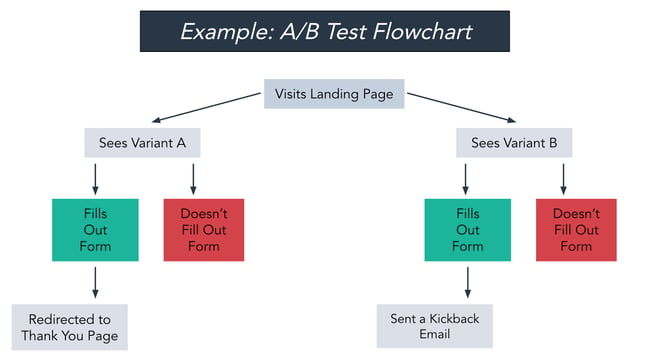
This template visualizes how a user visiting a company's landing page could convert and become a lead. Notice how there are two potential final outcomes, but because of this chart's simplicity, you can add as many outcomes as you want. With a flowchart like this, it's important to have clear, defined goals in mind.
2. Swimlane Flowchart Example
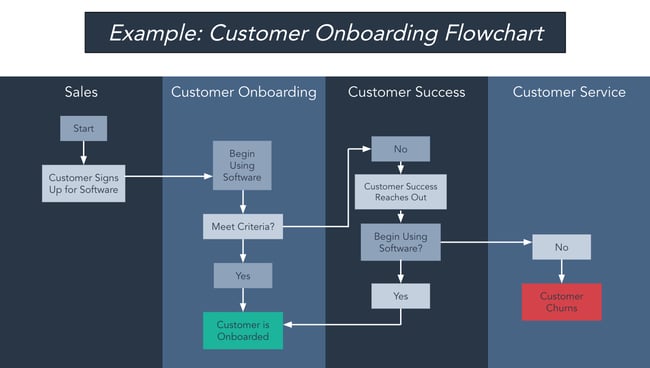
In the example above, the swimlanes are divided by department to illustrate the process of the customer journey. This is exceedingly important for determining which teams need to interact with a customer and when. Without a swimlane flowchart outlining these roles, your customers' experience with your company can seem haphazard and poorly planned.
3. Task Flowchart Example
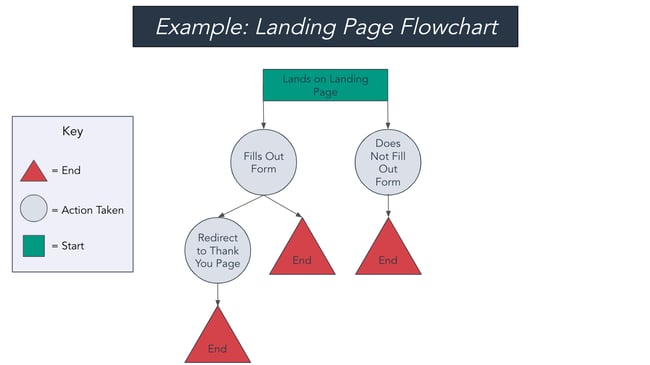
In the example above, the different shapes represent the start of, end of, and actions taken during the process of viewing a landing page. This task flowchart example follows an "if this, then that" format, showing the various outcomes that could occur when a potential customer visits a landing page.
4. Complex Flowchart Example

The above hiring visual is an example of a complex flowchart that has various events and potential outcomes. It accounts for two potential outcomes at every stage, and shows with clarity what happens as a candidate moves forward. The colors also make it clear which one is the positive final outcome and which ones are the negative final outcomes.
5. Circular Flowchart Example
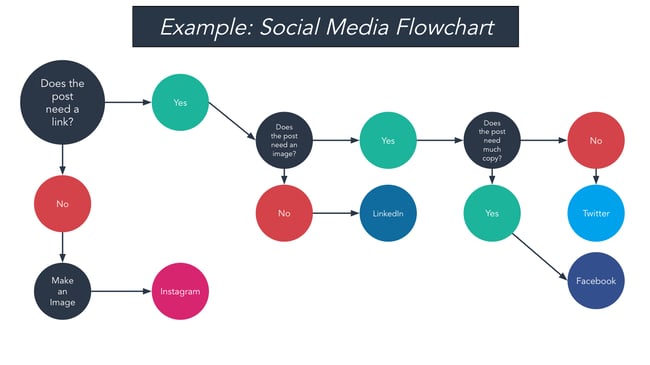
In the example above, a circular flowchart is used as a decision-making framework. Here, it's used to help a social media manager determine which site should be used to post content on. It includes specific, targeted questions that determine the assets the social media manager needs to create, and which social platforms these assets are best suited for.
6. Linear Flowchart Example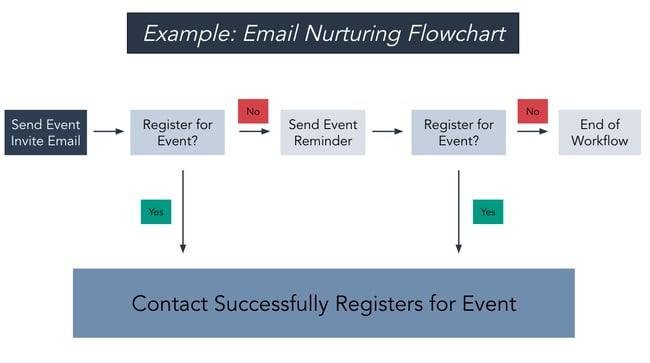
A linear flowchart can be used for processes that have only one desired outcome. In the above example, it's for an email nurturing sequence. In the image, the process ends whether someone signs up for an event or not. A time-bound (or finite) email nurturing sequence is especially a good fit for these types of flowcharts. For continuous email marketing campaigns, you might need a more agile flowchart where you can determine when to move a subscriber to another email list.
7. Tree Flowchart Example
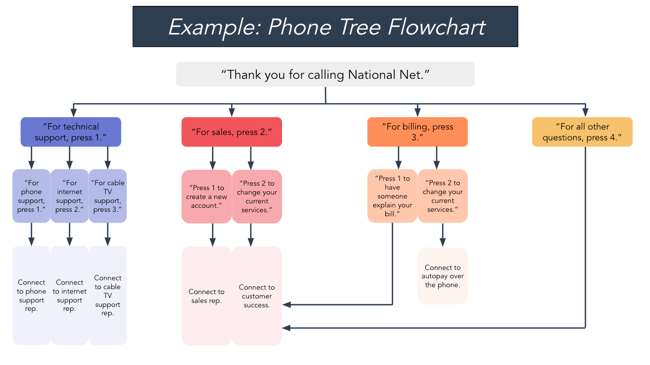
In this tree flowchart example, a business depicts the various options and next steps a caller can take when contacting them via telephone. Notice that there are various end points for the customer depending on their previous action. A flowchart like this is useful if you're trying to outline a process with different "branches." For instance, you might create a landing page flowchart that determines which form or CTA is depicted to a customer based on their previous activity on your website.
8. Organizational Flowchart Example
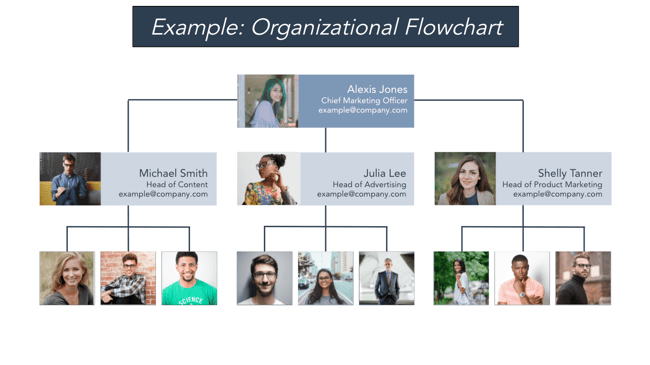
While not exactly procedural, this visualization helps those within the company quickly understand who reports to whom and who is responsible for what. The best part of this example is that it can be as a detailed or as simple as you'd like it to be; you can go down to your junior individual contributors or simply outline your leadership map.
Using Business Flowchart Templates
Business flowchart templates are the fastest and easiest way to build flowcharts. All of the above templates are downloadable and are completely customizable when it comes to shape, format, color, and imagery. Click below to download the templates for free to better illustrate and communicate processes in your company.
Editor's note: This post was originally published in July 2018 and has been updated for comprehensiveness.



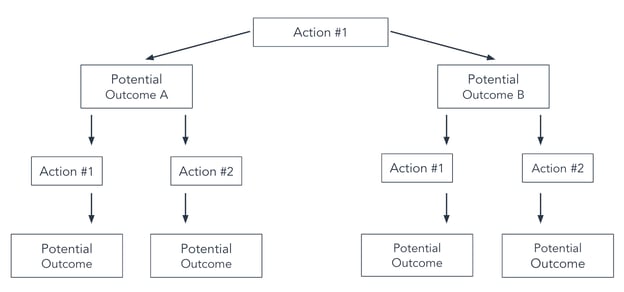
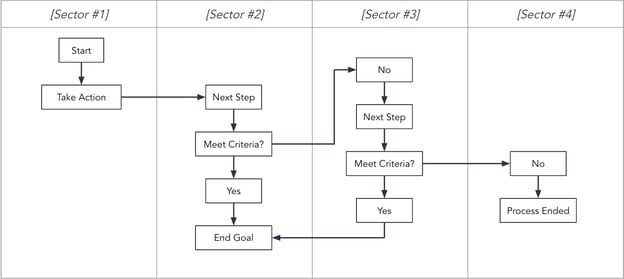
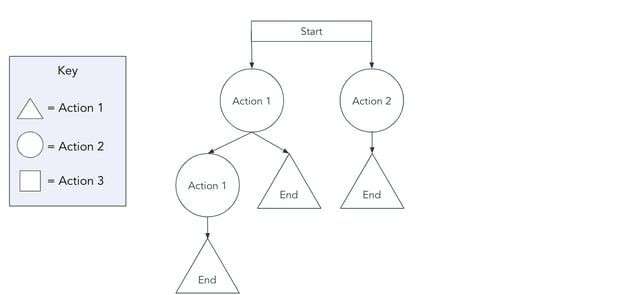
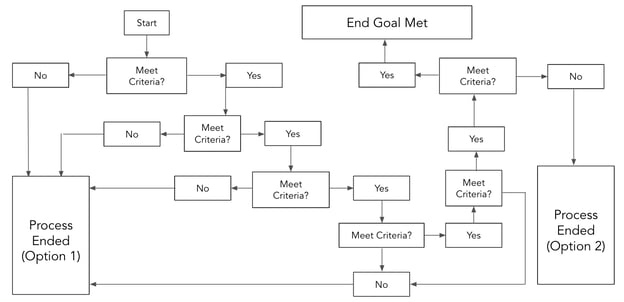
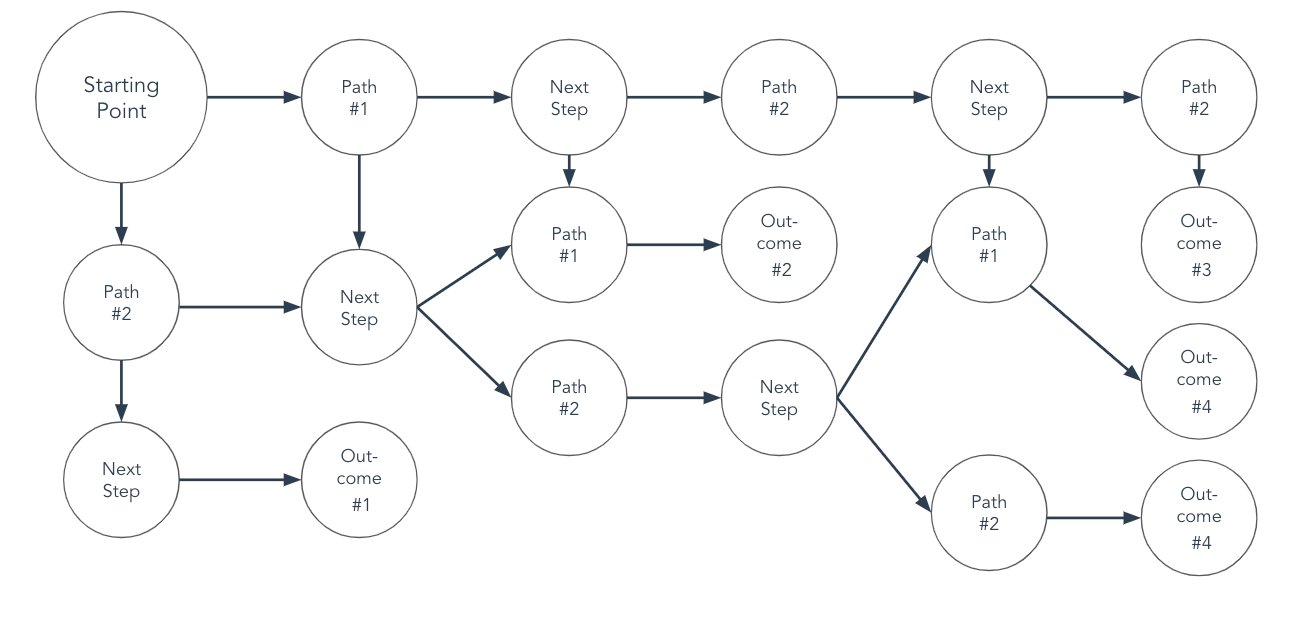
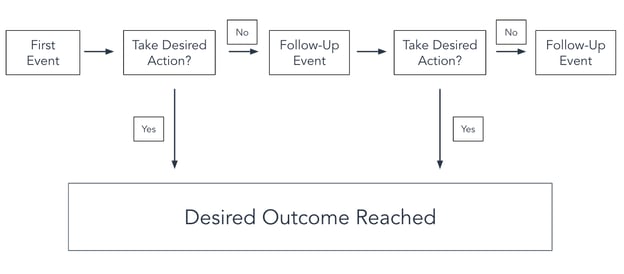

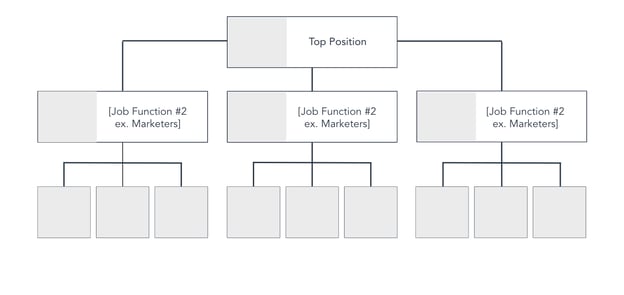
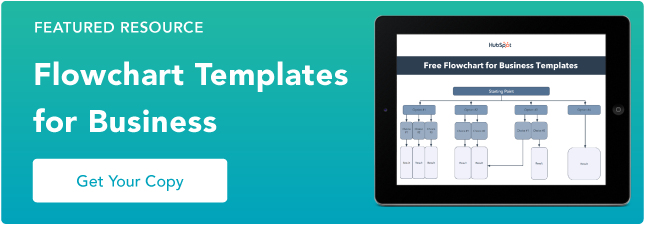


0 Comments